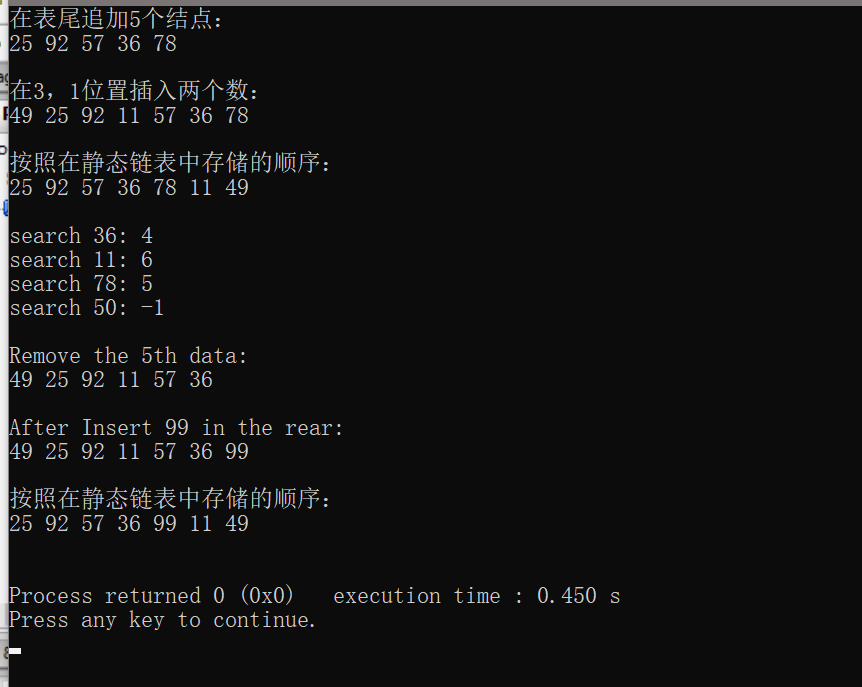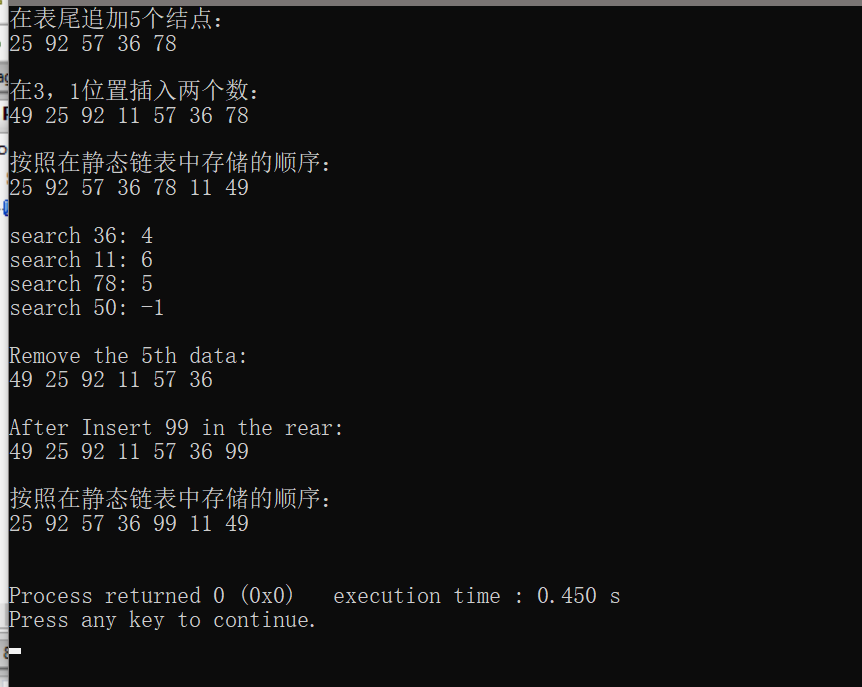
C++实现带头结点的静态链表
#ifndef STATICLIST_H #define STATICLIST_H #include <cassert> #include <iostream> using namespace std; ///带头结点的静态链表 const int defaultSize = 100; template <class T> struct SLinkNode { T data; int link; }; template <class T> class StaticList { SLinkNode<T> *elem; int maxSize; int avil;//可用结点链链首下标 public: StaticList(int sz = defaultSize); ~StaticList(); int Length();//返回表长 int Search(T x);//搜索x int Locate(int i);//定位第i个元素 bool getData(int i, T &x);//获取第i个元素的值 bool Append(T x); //在表尾添加新结点 bool Insert(int i, T x); //在第i个位置上插入元素x bool Remove(int i);//删除第i个位置上元素 bool IsEmpty();//判断表是否为空 void output(int type = 0)//按指定格式输出 { if(type != 1) { int l = 0; while(elem[l].link != -1) { int t = elem[l].link; cout<<elem[t].data<<' '; l = elem[l].link; } cout<<endl; } else{ for(int j=1;j<avil;j++) cout << elem[j].data<<' ' ; cout <<endl; } } friend istream& operator >> (istream& in, StaticList<T> &stl) { T data; while (!in.eof()) //在原链表后添加,与其他线性表不同 { in >> data; stl.Append(data); } return in; } friend ostream & operator<<(ostream &out, StaticList <T> &stl) { int p = stl.elem[0].link;//elem[0]为附加头结点 while(p != -1) { cout << stl.elem[p].data << endl; p = stl.elem[p].link; } cout << endl; return out; } }; template <class T> StaticList<T>::StaticList(int sz) { if(sz>0) { maxSize = sz; avil = 1; elem = new SLinkNode<T>[maxSize]; elem[0].link = -1; for(int i=1; i<maxSize-1; i++) elem[i].link = i+1; elem[maxSize-1].link = -1; } } template <class T> StaticList<T>::~StaticList() { delete []elem; } template <class T> int StaticList<T>::Length()//返回表长 { int f = elem[0].link; int sum = 0; while(f != -1) { f = elem[f].link; sum++; } return sum; } template <class T> int StaticList<T>::Search(T x)//搜索x { int f = elem[0].link; while(f != -1) { if(x == elem[f].data) break; else f = elem[f].link; } return f; } template <class T> int StaticList<T>::Locate(int i)//定位第i个元素 { if(i < 0) return -1; if(i == 0) return 0; int f = elem[0].link; int s = 1; while(f != -1 && s<i) { f = elem[f].link; s++; } return s; } template <class T> bool StaticList<T>::getData(int i, T &x)//获取第i个元素的值 { int loc = Locate(i); if(loc==0 || loc==-1) return false; x = elem[loc].data; return true; } template <class T> bool StaticList<T>::Append(T x) //在表尾添加新结点 { if(avil == -1) return false; int q = avil; avil = elem[avil].link; elem[q].data = x; elem[q].link = -1; int p = 0; while(elem[p].link != -1) p = elem[p].link; elem[p].link = q; return true; } template <class T> bool StaticList<T>::Insert(int i, T x) //在第i个位置上插入元素x { int p = Locate(i-1); if(p==-1) return false; int q = avil; avil = elem[avil].link; elem[q].data = x; elem[q].link = elem[p].link; elem[p].link = q; return true; } template <class T> bool StaticList<T>::Remove(int i)//删除第i个位置上元素 { int p = Locate(i-1); if(p == -1) return false; int q = elem[p].link; elem[p].link = elem[q].link; elem[q].link = avil; avil = q; return true; } template <class T> bool StaticList<T>::IsEmpty()//判断表是否为空 { if(elem[0].link == -1) return true; else return false; } //template <class T> //void StaticList<T>::output(int type=0)//按指定格式输出 #endif int main() { StaticList<int> list(10); list.Append(25); list.Append(92); list.Append(57); list.Append(36); list.Append(78); cout<<"在表尾追加5个结点:"<<endl; list.output(); cout << endl; cout<<"在3,1位置插入两个数:"<<endl; list.Insert(3, 11); list.Insert(1, 49); list.output(); cout << endl; cout<<"按照在静态链表中存储的顺序:"<<endl; list.output(1); cout << endl; cout << "search 36: " << list.Search(36) << endl; cout << "search 11: " << list.Search(11) << endl; cout << "search 78: " << list.Search(78) << endl; cout << "search 50: " << list.Search(50) << endl; cout << endl; if (list.Remove(5)) { cout << "Remove the 5th data: "; list.output(); } cout << endl; list.Append(99); cout << "After Insert 99 in the rear: "; list.output(); cout << endl; cout<<"按照在静态链表中存储的顺序:"<<endl; list.output(1); cout << endl; return 0; }
#运行结果#

